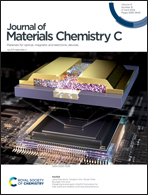Electrochemical phase transition of ionic hydrogels†
Abstract
Surface-patterned phase transition on network-homogeneous hydrogels remains a challenge. Herein, a general electrochemistry protocol is proposed which changes the local pH by electrode reactions, and enables a spatially patterned phase transition on the surface of hydrogels. We introduce bis-quaternary ammonium (BQA) salts with cationic groups of (C2H5)3N+ into a hydrogel network containing carboxylic acid moieties. Upon applying electricity at 3 V, the cathode reaction generates OH− ions that neutralize carboxylic acid (COOH) moieties into carboxylate (COO−) groups. The electrostatic interaction between COO− and (C2H5)3N+ decreases the local hydrophilicity of the network, and results in the phase transition of the hydrogel into a white state. By applying acid solution in the phase-transition areas, the carboxylate groups are protonated into carboxylic acid groups, which breaks the electrostatic interaction, and brings the phase-transition areas back to the transparent state. Such a reversible phase transition allows for writing, storing, and erasing of complicated information on the hydrogel surface, showing great potential for application in informatics, cryptology, and security areas.



 Please wait while we load your content...
Please wait while we load your content...